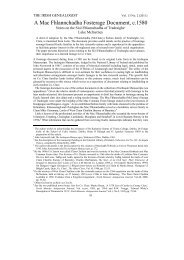Report Cover Vol I - Clare County Library
Report Cover Vol I - Clare County Library
Report Cover Vol I - Clare County Library
You also want an ePaper? Increase the reach of your titles
YUMPU automatically turns print PDFs into web optimized ePapers that Google loves.
The <strong>County</strong> <strong>Clare</strong> Wetlands Survey Patrick Crushell & Peter Foss 2008<br />
___________________________________________________________<br />
Raised bogs<br />
Priority habitat under the EU Habitats Directive.<br />
Raised bogs are accumulations of deep acid peat (3-12<br />
m) that originated in shallow lake basins or topographic<br />
depressions at the end of the last glaciation 10,000<br />
years ago. The name is derived from the elevated<br />
surface, or dome, that develops as raised bogs grow<br />
upwards from the surface accumulating organic<br />
material; the domed effect is often exaggerated when<br />
the margins of a bog are damaged by turf cutting or<br />
drainage, and are drying out.<br />
The surface of a relatively intact raised bog is<br />
typically wet, acid and deficient in plant nutrients (as<br />
bogs receive most of nutrients through rainfall), and<br />
supports specialised plant communities that are low in<br />
overall diversity. The vegetation is open and colourful<br />
Sphagnum mosses dominate the ground layer. Raised<br />
bogs are most abundant in the lowlands of<br />
central and mid-west Ireland.<br />
Intact actively growing raised bog is extremely rare,<br />
having decreased in area by over 35% in the last 10<br />
years. Ongoing deterioration of the<br />
hydrological conditions of raised bogs at current rates<br />
caused by peat cutting, drainage, forestry and burning<br />
severely threatens the viability of the habitat at most<br />
locations in Ireland.<br />
Examples of this habitat type include Tullagher Lough and Bog SAC and Red Bog - O'Briensbridge cNHA.<br />
Upland blanket bog<br />
Priority habitat under the EU Habitats Directive,<br />
provided that active peat accumulation is occurring<br />
within a site.<br />
Upland blanket bog occurs on flat or gently sloping<br />
ground above 150 m and is widespread on hills and<br />
mountains throughout Ireland. The 150 m limit serves<br />
to distinguish upland from lowland blanket bog but is<br />
loosely applied. Peat depths vary and normally fall in the<br />
range of 1-2 m, but can be much deeper in pockets.<br />
Upland blanket bog can be extremely wet where it<br />
occurs on level terrain and may have surface drainage<br />
features that are typical of lowland blanket bog.<br />
Blanket bog areas support a number of EU species including<br />
Irish Hare, Red Grouse, Curlew, Golden Plover<br />
and Hen Harrier.<br />
Current pressures and threats include overstocking by<br />
grazing animals (especially sheep), peat erosion,<br />
drainage, burning and infrastructural developments (i.e.<br />
windfarms).<br />
Good examples of this habitat occur within the Lough<br />
Atorick Bogs NHA in the eastern part of the <strong>County</strong>.<br />
28
















